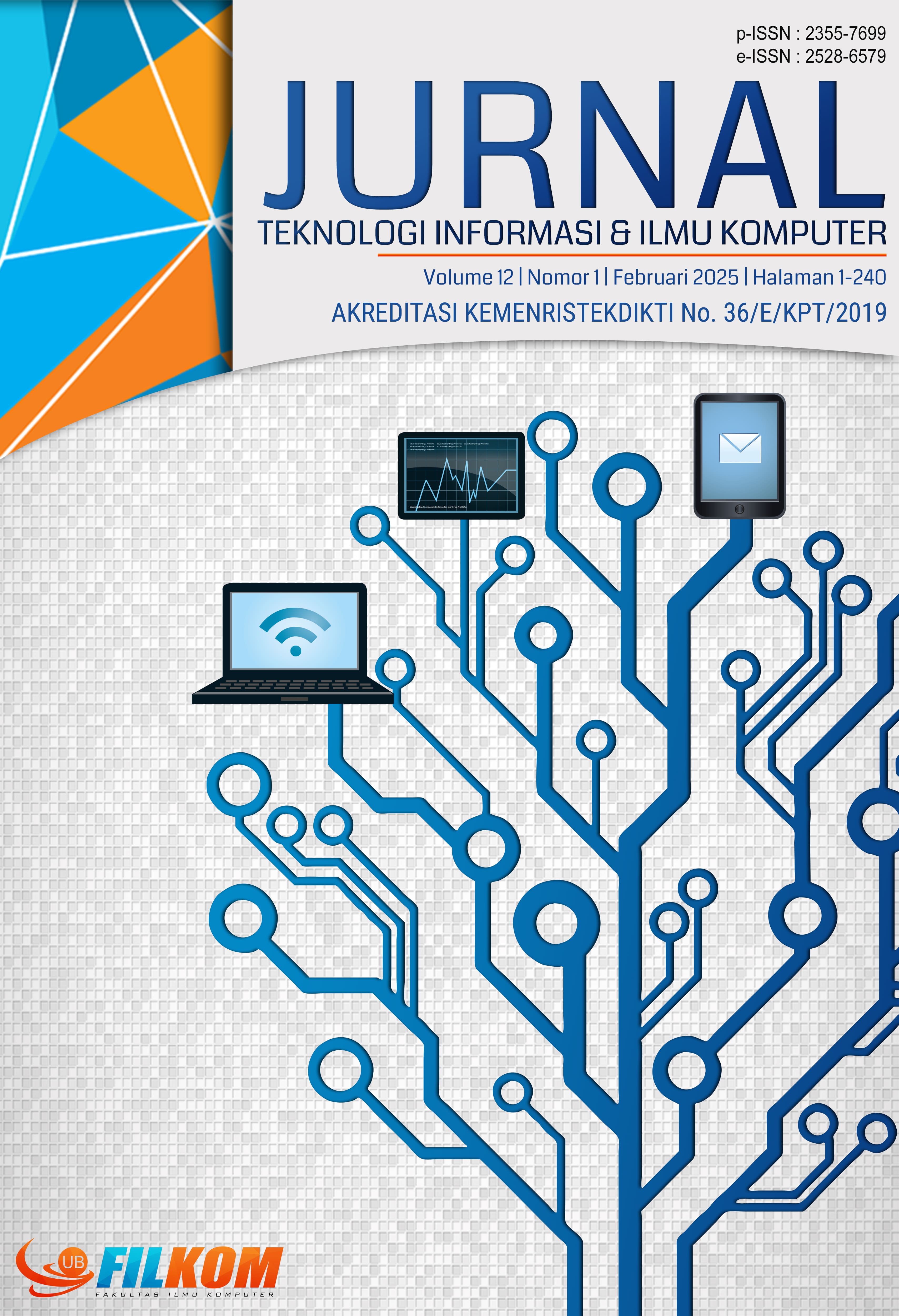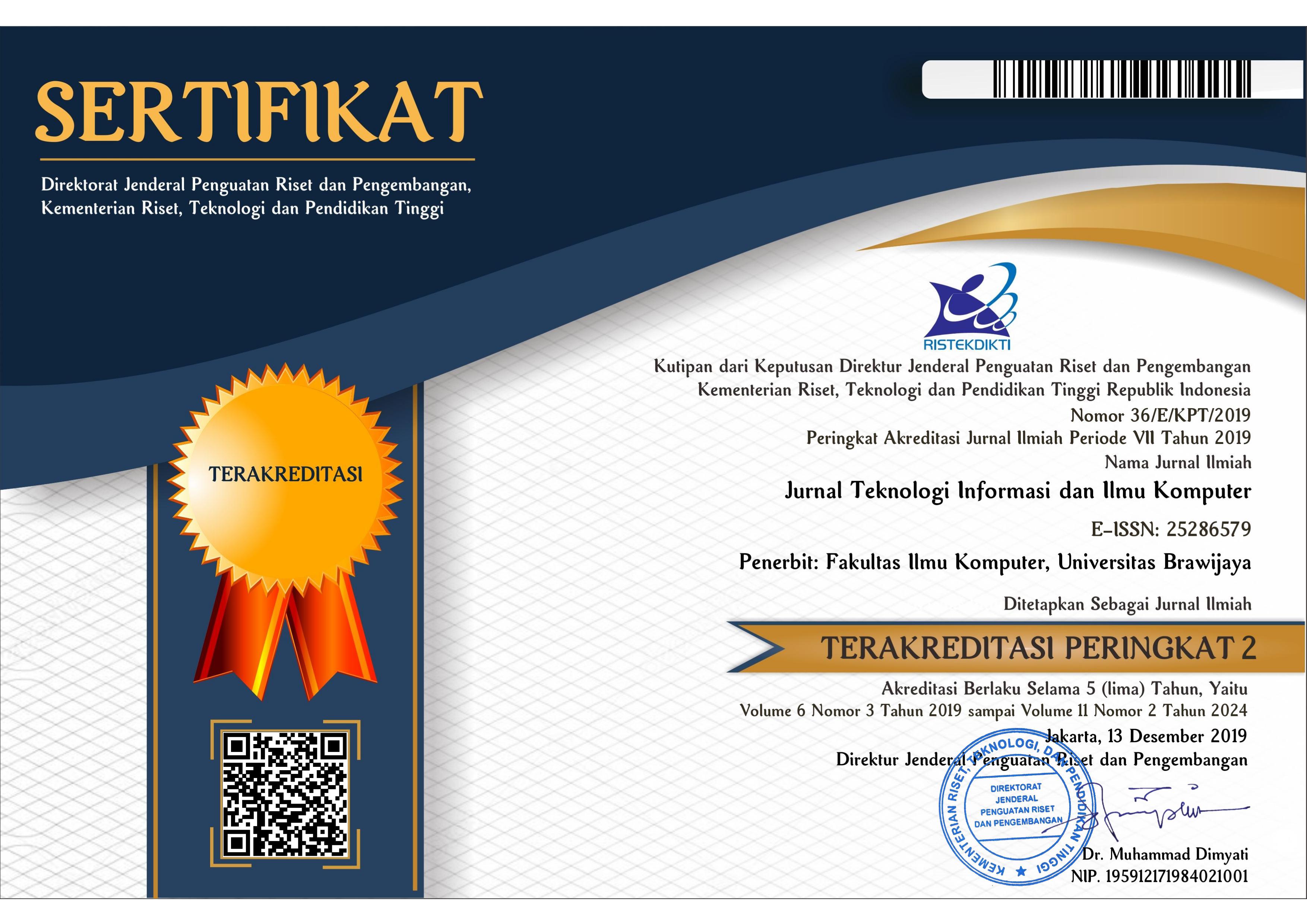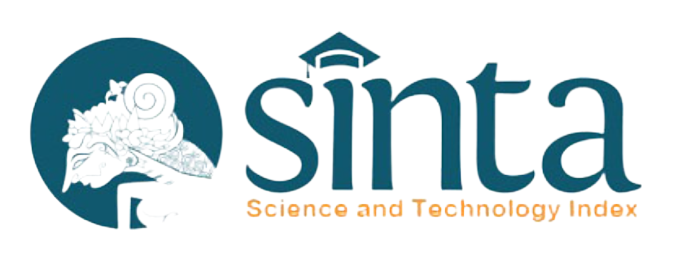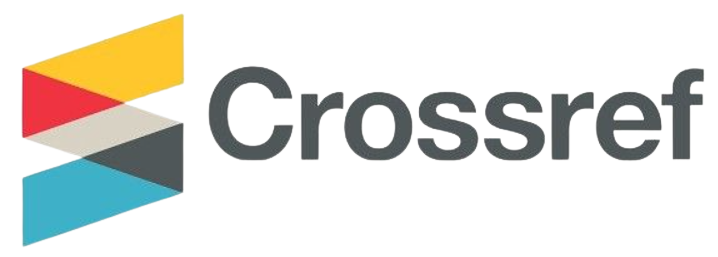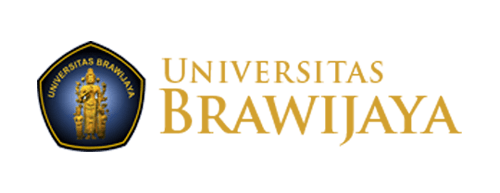Penerapan Teachable Machine Dan Raspberry Pi Pada Sistem Klasifikasi Citra Untuk Inspeksi Cacat Kain
DOI:
https://doi.org/10.25126/jtiik.2025128932Kata Kunci:
Klasifikasi citra, Machine learning, Teachable Machine, Raspberry Pi, Inspeksi cacat kainAbstrak
Industri tekstil memainkan peran krusial dalam ekonomi nasional, menghadapi tantangan signifikan dalam menjaga kualitas produk untuk memenuhi kepuasan konsumen. Cacat produksi, seperti cacat jarang dan cacat slap pada kain, merupakan salah satu faktor utama yang mempengaruhi kualitas produk tekstil. Penelitian ini bertujuan untuk mengembangkan sistem inspeksi cacat kain secara otomatis dengan menggunakan metode pemrosesan citra digital dan machine learning. Sistem ini dirancang untuk diintegrasikan pada mesin penggulungan kain sebagai sistem inspeksi awal sebelum kain didistribusikan. Metode yang digunakan meliputi supervised learning untuk klasifikasi citra kain, memanfaatkan perangkat lunak Google Teachable Machine dan algoritma Convolutional Neural Network (CNN) yang diimplementasikan dengan OpenCV. Perangkat keras yang digunakan terdiri dari kamera web Logitech D320 untuk akuisisi gambar dan Raspberry Pi-3B sebagai pengolah citra. Sistem ini diuji untuk mendeteksi tiga kategori kain: kain bagus, cacat jarang, dan cacat slap. Hasil pengujian menunjukkan bahwa sistem memiliki rata-rata waktu inferensi sebesar 142,47 ms dengan kecepatan rata-rata 6,46 frame per detik (FPS) dan akurasi klasifikasi mencapai 98,48%. Dengan implementasi sistem ini, diharapkan dapat meningkatkan efisiensi produksi, memperkuat kontrol kualitas di industri tekstil, mengurangi intervensi manual, dan menurunkan potensi kerugian akibat produk cacat.
Abstract
The textile industry plays a crucial role in the national economy, facing significant challenges in maintaining product quality to meet consumer satisfaction. Production defects, such as rare defects and slap defects in fabrics, are key factors that affect the quality of textile products. This research aims to develop an automated fabric defect inspection system using digital image processing and machine learning methods. The system is designed to be integrated into fabric winding machines as an initial inspection system before the fabric is distributed. The methods used include supervised learning for fabric image classification, utilizing Google Teachable Machine software and the Convolutional Neural Network (CNN) algorithm implemented with OpenCV. The hardware used consists of a Logitech D320 webcam for image acquisition and a Raspberry Pi-3B as the image processor. The system was tested to detect three categories of fabric: good fabric, rare defects, and slap defects. The test results showed that the system achieved an average inference time of 142.47 ms with an average speed of 6.46 frames per second (FPS) and a classification accuracy of 98.48%. With the implementation of this system, it is expected to enhance production efficiency, strengthen quality control in the textile industry, reduce manual intervention, and decrease potential losses due to defective products.
Downloads
Referensi
AFAQ, S., & RAO, S. 2020. Significance Of Epochs On Training A Neural Network. International Journal of Scientific & Technology Research, 9(06), 1–4. www.ijstr.org
AJHARI, A. A., SITORUS, K. J., LYRAWATI, D. P. N., SRIDANA, E. F. S., LESTARI, R., & FARIDA, W. V. 2023. Noaa Image Classification Using Google’S Teachable Machine. Semnas Ristek (Seminar Nasional Riset Dan Inovasi Teknologi), 7(1), 43–49. https://doi.org/10. 30998/semnasristek.v7i1.6244
ALI, A., PINCIROLI, R., YAN, F., & SMIRNI, E. 2020. Batch: Machine learning inference serving on serverless platforms with adaptive batching. International Conference for High Performance Computing, Networking, Storage and Analysis, SC, 2020-Novem. https://doi.org/10.1109/ SC41405.2020.00073
ANGELOPOULOS, A. N., KOHLI, A., BATES, S., JORDAN, M. I., MALIK, J., ALSHAABI, T., UPADHYAYULA, S., & ROMANO, Y. 2022. Image-to-Image Regression with Distribution-Free Uncertainty Quantification and Applications in Imaging. Proceedings of Machine Learning Research, 162, 717–730.
ARIF, M. S., PUTRI, C. F., & TJAHJONO, N. 2018. Peningkatan Grade Kain Sarung dengan Mengurangi Cacat Menggunakan Metode Kaizen dan Siklus PDCA pada PT . X. 26(2), 222–231.
AZMI, K., DEFIT, S., & SUMIJAN, S. 2023. Implementasi Convolutional Neural Network (CNN) Untuk Klasifikasi Batik Tanah Liat Sumatera Barat. Jurnal Unitek, 16(1), 28–40. https://doi.org/10.52072/unitek.v16i1.504
BOUSSEMART, Y., CUMMINGS, M. L., LAS FARGEAS, J., & ROY, N. 2011. Supervised vs unsupervised learning for operator state modeling in unmanned vehicle settings. Journal of Aerospace Computing, Information and Communication, 8(3), 71–85. https://doi.org/ 10.2514/1.46767
BUYUT KHOIRUL UMRI, & DELICA, V. 2021. Penerapan transfer learning pada convolutional neural networks dalam deteksi covid-19. Jnanaloka, 9–17. https://doi.org/10.36802/jnanaloka.2021 .v2-no2-9-17
CHENG, P., CHIEN, B., & YANG, W. 2014. Medical Image Classification by Supervised Machine Learning. June.
DASH, M., LIU, H., & YAO, J. 1997. Dimensionality reduction of unsupervised data. Proceedings of the International Conference on Tools with Artificial Intelligence, April, 532–539. https://doi.org/10.1109/tai.1997.632300
DIANTORO, K., ADRIASYAH, B., INTEGRAL, C., & AWAL, P. C. 2019. Sistem Identifikasi Jenis Burung Dengan Image. 20(1), 96–105.
GOLDBERGER, J., GORDON, S., & GREENSPAN, H. 2006. Unsupervised image-set clustering using an information theoretic framework. IEEE Transactions on Image Processing, 15(2), 449–458. https://doi.org/10.1109/TIP.2005.860593
HANDA, N., KAUSHIK, Y., SHARMA, N., DIXIT, M., & GARG, M. 2021. Image Classification Using Convolutional Neural Networks. Communications in Computer and Information Science, 1393 (December 2022), 510–517. https://doi.org/10.1007/978-981-16-3660-8_48
ID, I. D. 2021. Machine Learning : Teori , Studi Kasus dan Implementasi Menggunakan Python. July. https://doi.org/10.5281/zenodo. 5113507
JASWAL, D., V, S., & SOMAN, K. P. 2014. Image Classification Using Convolutional Neural Networks. International Journal of Scientific and Engineering Research, 5(6), 1661–1668. https://doi.org/10.14299/ijser.2014.06.002
KAMPEZIDOU, S. I., RAY, A. T., BHAT, A. P., FISCHER, O. J. P., & MAVRIS, D. N. 2024. Fundamental Components and Principles of Supervised Machine Learning Workflows with Numerical and Categorical Data. 384–416.
KASUS, S., ISKANDAR, P. T., PRINTING, I., DEWANTI, D. F., & PUJOTOMO, D. (n.d.). Analisis Penyebab Cacat Produk Kain Dengan Menggunakan Metode Failure Mode And Effect Analysis ( FMEA ).
KOTTA, C. R., PASERU, D., & SUMAMPOUW, M. 2022. Implementasi Metode Convolutional Neural Network untuk Mendeteksi Penyakit Pada Citra Daun Tomat. Jurnal Pekommas, 7(2), 123–132. https://doi.org/10.56873/jpkm.v7i2.4961
LINDHOLM, A., WAHLSTRÖM, N., LINDSTEN, F., & SCHÖN, T. B. 2019. Supervised Machine Learning: Statistical Machine Learning course. 112.
http://www.it.uu.se/edu/course/homepage/sml/literature/lecture_notes.pdf
MISHRA, D. P., MISHRA, S., JENA, S., & SALKUTI, S. R. 2023. Image classification using machine learning. Indonesian Journal of Electrical Engineering and Computer Science, 31(3), 1551–1558. https://doi.org/10.11591/ijeecs. v31.i3.pp1551-1558
NUGROHO, E. A., SETIAWAN, J. D., MUNADI, & DIKI. 2024. Design of image classification system for fabric inspection process using Raspberry Pi. Journal of Mechatronics, Electrical Power, and Vehicular Technology, 15(1), 57–67. https://doi.org/10.55981/j.mev.2024.863
NURHADI, M., & PURNOMO, J. 2022. Implementation of Image Classification Using Convolutional Neural Network (Cnn) Algorithm on Vehicles Images. ASEAN Journal of Systems Engineering, 6(1), 1–5. https://doi.org/10.22146/ajse.v6i1.72411
OLAODE, A., NAGHDY, G., & TODD, C. 2014. Unsupervised classification of images: a review. International Journal of Image Processing., 8.5, 325–342. https://www.researchgate.net/profile/Abass-Olaode/publication/265729668_Unsupervised_Classification_of_Images_A_Review/links/541a74be0cf203f155ae295a/Unsupervised-Classification-of-Images-A-Review.pdf
RADIUK, P. M. 2018. Impact of Training Set Batch Size on the Performance of Convolutional Neural Networks for Diverse Datasets. Information Technology and Management Science, 20(1), 20–24. https://doi.org/10.1515/ itms-2017-0003
RELIGIA, Y. 2019. Feature Extraction Untuk Klasifikasi Pengenalan Wajah Menggunakan Support Vector Machine Dan K-Nearest Neighbor. Pelita Teknologi: Jurnal Ilmiah Informatika, Arsitektur Dan Lingkungan, 14(2), 85–92.
ROCHMAWATI, N., HIDAYATI, H. B., YAMASARI, Y., TJAHYANINGTIJAS, H. P. A., YUSTANTI, W., & PRIHANTO, A. 2021. Analisa Learning Rate dan Batch Size pada Klasifikasi Covid Menggunakan Deep Learning dengan Optimizer Adam. Journal of Information Engineering and Educational Technology, 5(2), 44–48. https://doi.org/10.26740/ jieet.v5n2.p44-48
SANJAYA, J., & AYUB, M. 2020. Augmentasi Data Pengenalan Citra Mobil Menggunakan Pendekatan Random Crop, Rotate, dan Mixup. Jurnal Teknik Informatika Dan Sistem Informasi, 6(2), 311–323. https://doi.org/10.28932/jutisi.v6i2.2688
Unduhan
Diterbitkan
Terbitan
Bagian
Lisensi
Hak Cipta (c) 2025 Jurnal Teknologi Informasi dan Ilmu Komputer

Artikel ini berlisensiCreative Commons Attribution-ShareAlike 4.0 International License.

Artikel ini berlisensi Creative Common Attribution-ShareAlike 4.0 International (CC BY-SA 4.0)
Penulis yang menerbitkan di jurnal ini menyetujui ketentuan berikut:
- Penulis menyimpan hak cipta dan memberikan jurnal hak penerbitan pertama naskah secara simultan dengan lisensi di bawah Creative Common Attribution-ShareAlike 4.0 International (CC BY-SA 4.0) yang mengizinkan orang lain untuk berbagi pekerjaan dengan sebuah pernyataan kepenulisan pekerjaan dan penerbitan awal di jurnal ini.
- Penulis bisa memasukkan ke dalam penyusunan kontraktual tambahan terpisah untuk distribusi non ekslusif versi kaya terbitan jurnal (contoh: mempostingnya ke repositori institusional atau menerbitkannya dalam sebuah buku), dengan pengakuan penerbitan awalnya di jurnal ini.
- Penulis diizinkan dan didorong untuk mem-posting karya mereka online (contoh: di repositori institusional atau di website mereka) sebelum dan selama proses penyerahan, karena dapat mengarahkan ke pertukaran produktif, seperti halnya sitiran yang lebih awal dan lebih hebat dari karya yang diterbitkan. (Lihat Efek Akses Terbuka).

